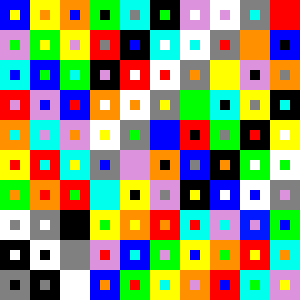Section 2.2 Quotient Spaces
We need a very different construction than what we used for direct sums; we now want to build an entirely new space from a given vector space
\(V\) and an arbitrry subspace
\(U.\) Let’s motivate this construction with a familiar example. Given a linear map
\(T:V\to
W\) with
\(T(v_0) = w\text{,}\) we characterized the inverve image,
\(T^{-1}(w)\) in Equation
(1.2.1) as
\begin{equation*}
T^{-1}(w) = \{v_0+k \mid k \in \ker(T)\} = v_0 +
\ker(T).
\end{equation*}
Let’s put an equivalence relation on \(V\) by saying that \(v_1 \sim v_2\) if and only if \(v_1-v_2 \in \ker(T).\) It is easy to check that this can be rephrased as \(v_1\sim
v_2\) if and only if \(T(v_1) = T(v_2).\) We let \(V/\ker(T)\) denote the set of equivalence classes. So if we let \([v]\) denote the equivalence class containing \(v,\) then
\begin{equation*}
V/\ker(T) = \{[v] \mid v\in V\}\text{ where } [v]=\{v+w
\mid w \in \ker(T)\}.
\end{equation*}
As a shorthand, we write
\begin{equation*}
v+\ker(T) := \{v+w \mid w \in \ker(T)\}.
\end{equation*}
Now there was nothing particularly special about using \(\ker(T)\) for the construction. So if \(V\) is a vector space, and \(U\) is any subspace, we define an equivalence relation on \(V\) by \(v_1 \sim_U v_2\) iff \(v_1-v_2\in
U\text{.}\) As in the previous example the equivalence classes have the form
\begin{equation*}
v+U := [v] = \{v +u \mid u \in U\}.
\end{equation*}
Finally, we denote by
\begin{equation*}
V/U = \{v+U\mid v\in V\} = \{[v]\mid v\in V\}.
\end{equation*}
Definition 2.2.1.
Let \(V\) be a vector space, and \(U\) any subspace. The set \(V/U\) is called a quotient space, and \(V/U\) is read \(V\) mod \(U\) or simply the quotient of \(V\) by \(U\). The elements \(v+U\) are called cosets of \(U\) in \(V.\)
As with any equivalence relation, the equivalence classes partition the original set, so that \(V\) is the disjoint union of the cosets:
\begin{equation*}
V = \bigsqcup_{v\in V} (v+U).
\end{equation*}
Example 2.2.2.
Let \(V=\R^2\) and \(U=\Span\{(a,b)\}\) where \((a,b)
\ne (0,0)\text{,}\) thus the subspace \(U\) is simply a line through the origin. Now let \(v=(c,d).\) Then the coset \(v+U\) is simply the line through \((c,d)\) in the direction of \((a,b).\) We also see that the union of these lines is all of \(V=\R^2.\)
Now that we understand \(V/U\) as a set, we want to introduce an algebraic structure on it inherited naturally from \(V.\) We define addition of cosets in a natural manner:
\begin{equation*}
(v+U) + (v'+U) := (v+v')+U.
\end{equation*}
It follows that the additive identity is \(0+U( = U)\text{,}\) the additive inverse of \(v+U\) is \(-v+U,\) and scalar multiplication is defined by \(\lambda (v+U) = \lambda v+U.\) One checks the operations are well-defined and makes \(V/U\) a vector space over the same scalar field as \(V.\)
One checks that \(V/\{0\} \cong V,\) and \(V/V\cong \{0\},\) but how to think about \(V/U\) in general is the subject of the next section.

